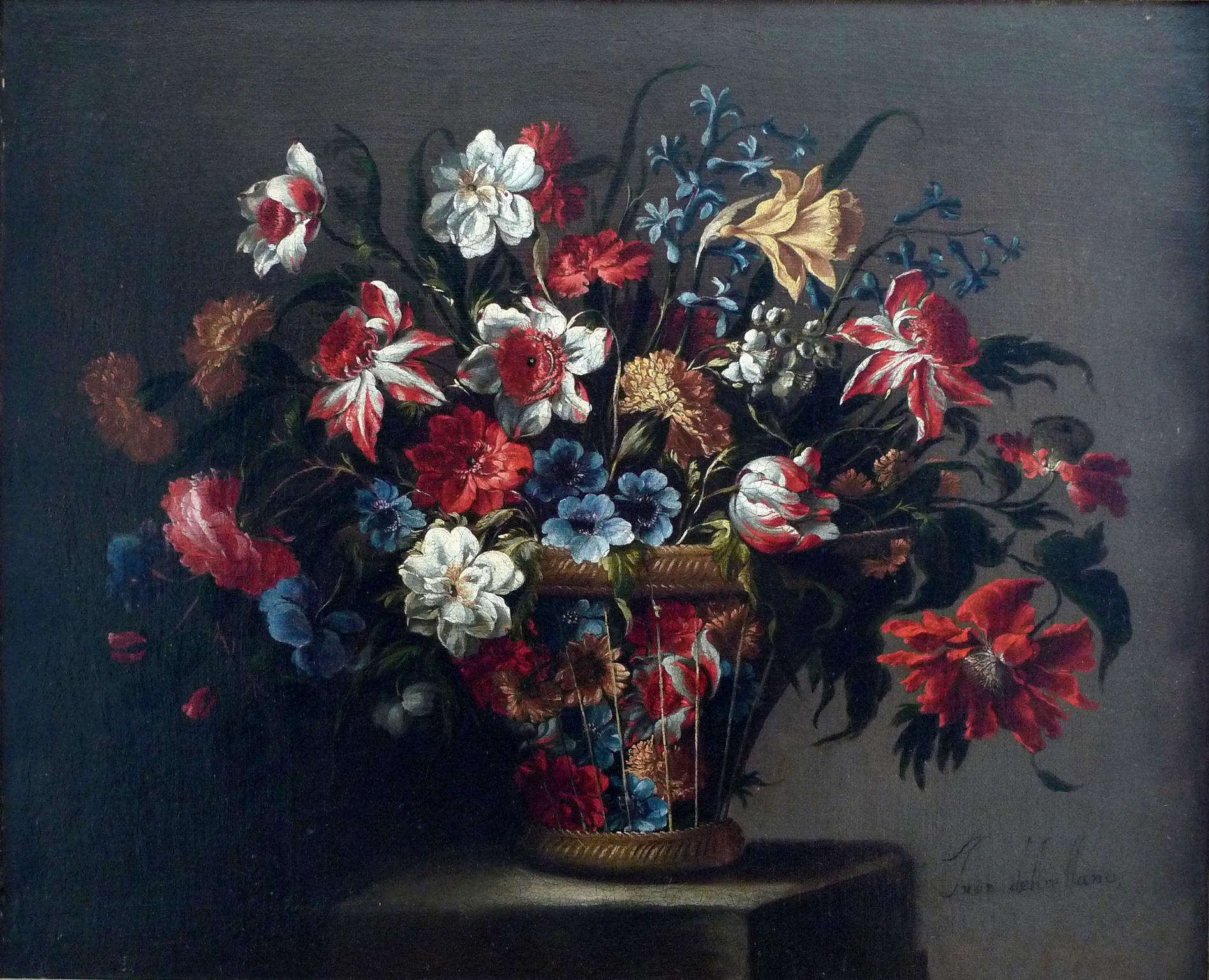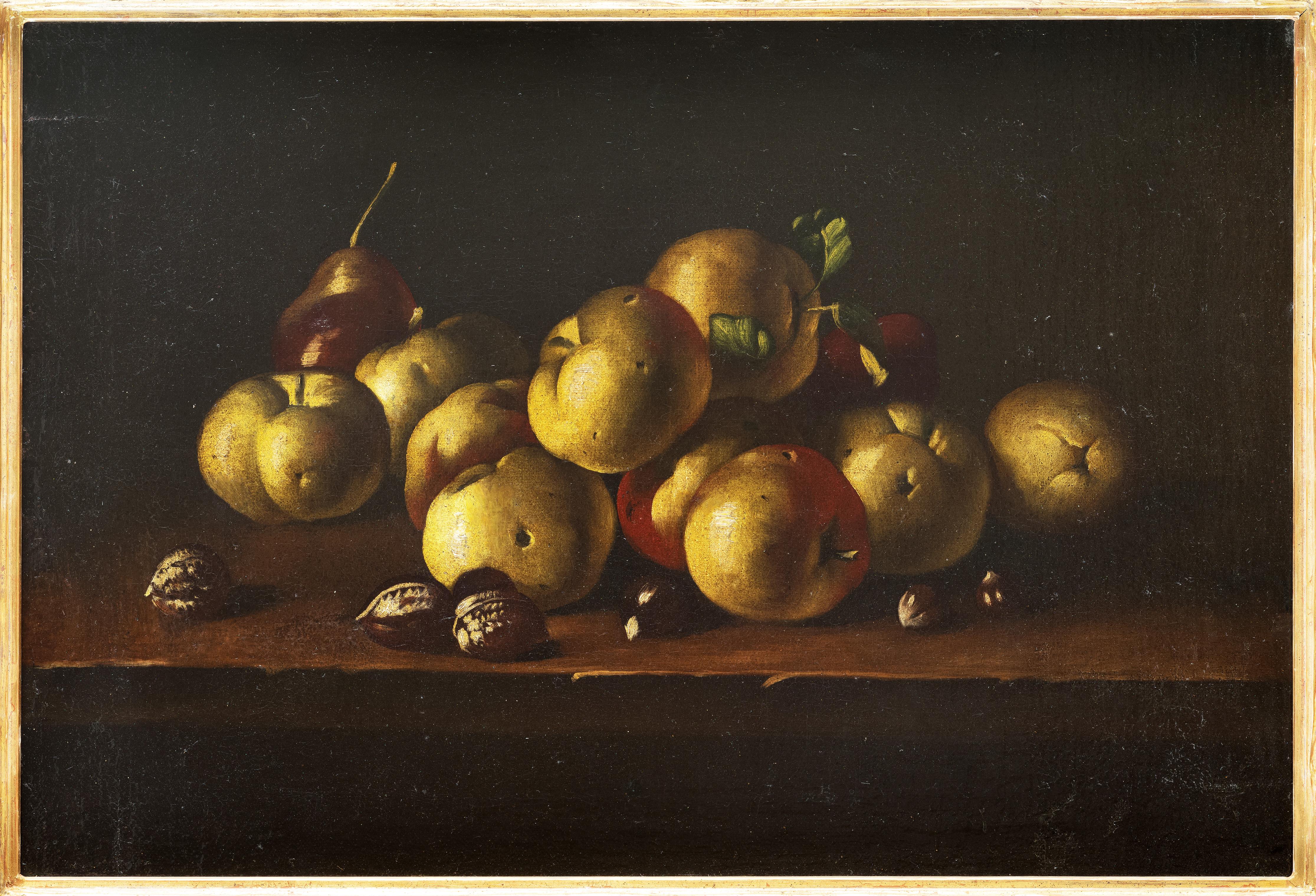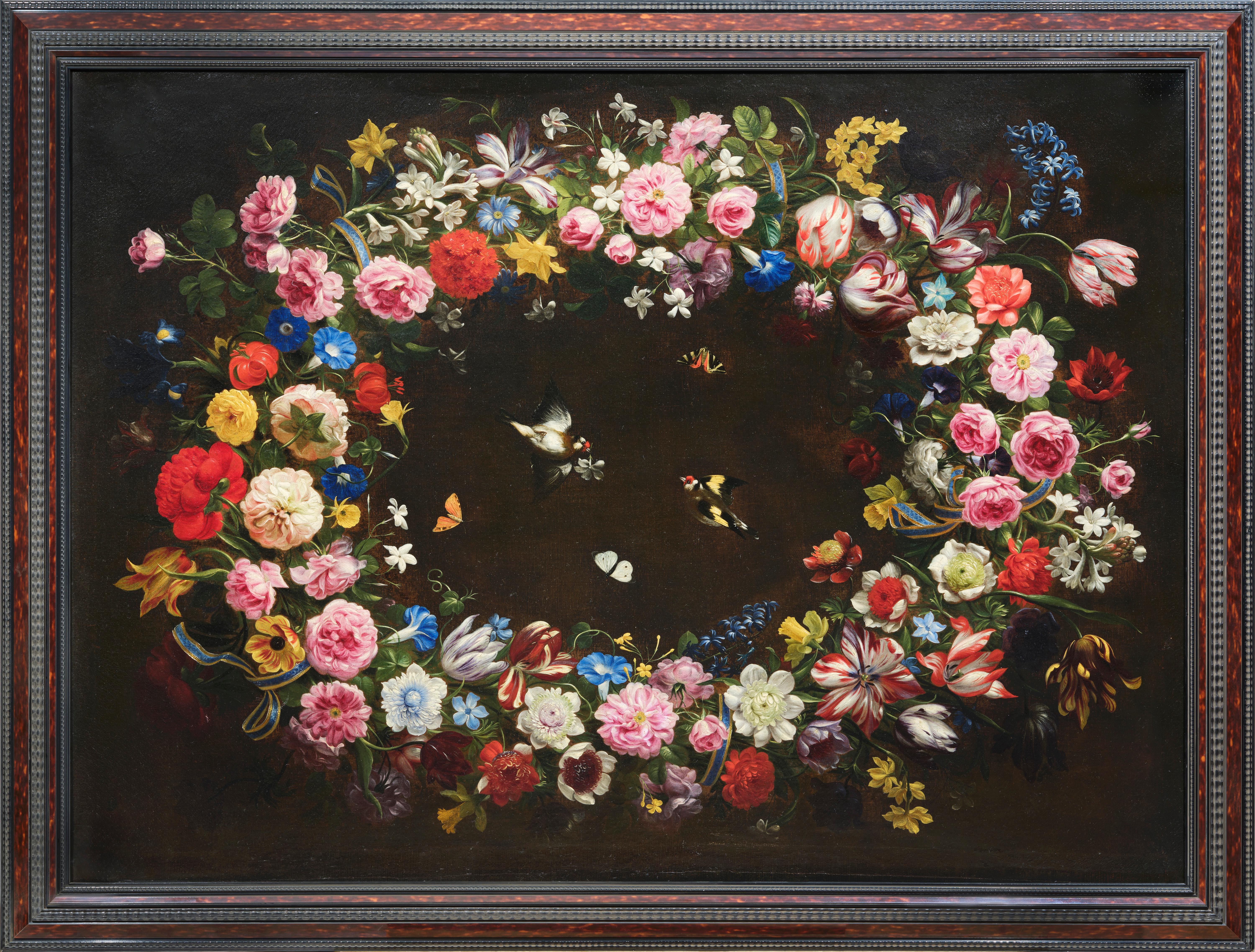Items Similar to Still Life of Fruit - Dutch 17th century art Old Master still life oil painting
Want more images or videos?
Request additional images or videos from the seller
1 of 24
Still Life of Fruit - Dutch 17th century art Old Master still life oil paintingCirca 1660
Circa 1660
About the Item
This stunning Dutch 17th century Old Master still life oil painting is attributed to the circle of Jan Davidsz de Heem. Painted circa 1660 it is a magnificent vibrant painting of grapes and peaches on a silver plate, a bowl of cherries, a glass rummer of wine and other fruits upon a draped table. The rich tones and sheen on the fruit is superb. An excellent example of a Dutch Old Master still life oil painting from the 17th century with good provenance.
Provenance. Bearing Christie's stencil and chalk marks verso.
Condition. Oil on canvas. Image size is 26 inches by 18 inches and in good condition. Paint thin in places.
Frame. Housed in a period Lely silvered panel frame. Framed size is 32 inches by 24 inches and in good worn condition.
Jan Davidsz de Heem (1606–1684). A Dutch Old Master painter. The painter known for his meticulously composed and finely detailed still life paintings and is a master in imitating the surface textures of various fruits, flowers, and objects.
- Creation Year:Circa 1660
- Dimensions:Height: 24 in (60.96 cm)Width: 32 in (81.28 cm)Depth: 2 in (5.08 cm)
- Medium:
- Movement & Style:
- Circle Of:Jan Davidsz. de Heem (1606 - 1684, Dutch)
- Period:
- Condition:
- Gallery Location:London, GB
- Reference Number:1stDibs: LU853113397392
About the Seller
5.0
Platinum Seller
These expertly vetted sellers are 1stDibs' most experienced sellers and are rated highest by our customers.
1stDibs seller since 2018
402 sales on 1stDibs
Typical response time: 1 hour
- ShippingRetrieving quote...Ships From: London, United Kingdom
- Return PolicyA return for this item may be initiated within 14 days of delivery.
More From This SellerView All
- Flowers in Vase on Ledge - Dutch 18thC Old Master floral still life oil paintingLocated in London, GBThis superb Dutch 18th century Old Master floral oil painting is ascribed verso to noted female artist Margaretha Haverman, only pupil of Jan van Huysum and has excellent provenance....Category
1740s Old Masters Still-life Paintings
MaterialsOil
- Still Life with Game, Fruit and Veg - Flemish 17thC Old Master art oil paintingLocated in London, GBPieter Boel, Flemish Old Master, painted this stunning 17th century still life oil painting. Painted circa 1660 it is a large and impressive still life with dead game surrounded by f...Category
17th Century Old Masters Still-life Paintings
MaterialsOil
- Table Top Still Life with Birds, Fruit and Walnuts - Old Master art oil paintingLocated in London, GBThis simply stunning German 18th century Old Master oil painting is by noted artist C.L. Braun, signed lower right on the table edge. It was painted circa 1780 and has the look of a...Category
1780s Old Masters Still-life Paintings
MaterialsOil
- Floral Arrangement in a Glass Vase - Dutch Old Master still life oil paintingBy Simon Pietersz Verelst (circle)Located in London, GBThis stunning 18th century Dutch Old Master Golden Age floral oil painting is attributed to a circle of Simon Pietersz Verelst. Painted circa 1720 it is a still life floral of a mixe...Category
1720s Old Masters Still-life Paintings
MaterialsOil
- Still Life Garland of Flowers - Flemish 18thC art Old Master floral oil paintingBy Pieter Casteels IIILocated in London, GBThis superb 18th century Old Master floral still life oil painting is attributed to Flemish artist Pieter Casteels III. Painted circa 1730 it is a garland or swag of flowers, somethi...Category
1730s Old Masters Still-life Paintings
MaterialsOil
- Still Life Arrangement - Dutch Old Master 17thC art oil painting fruit butterflyBy Leendert de LaeffLocated in London, GBA fine Dutch still life Old Master by Leendert de Laeff which is signed and dated 1664. This oil on canvas on panel depicts a still life of fruit with insects and butterflies. A supe...Category
17th Century Old Masters Still-life Paintings
MaterialsOil
You May Also Like
- Still Life with Fishes and Oysters - Oil on Canvas - 17th CenturyLocated in Roma, ITStill life with fishes and oysters is an original oil on canvas realized in the 17th Century by Neapolitan School Master. Impressive in size as well as for its vivid representation o...Category
17th Century Old Masters Still-life Paintings
MaterialsOil
- De Wit Flowers Still life Paint Oil on canvas 18th Century Flemish Cupids ArtLocated in Riva del Garda, ITJacob De Wit (Amsterdam, 1695 - 1754) attributable/ workshop Pair of Cupids with Garland of Flowers Oil on canvas 91 x 103 cm. - Framed 104 x 115 cm. Provenance: Christie's (London, Old master Painting 12.12.1996) lot 82 This magnificent composition depicts two cupids holding a garland of flowers, placed on a fine architecture with bas-reliefs and masks, presumably the top of a fountain. One of the two cupids sympathetically holds a part of it with his hands, while his head turns towards the viewer; the second cupid, on the other hand, must have clumsily broken the thread holding its end, and is sitting sullenly with a torch and a tear streaking his chubby cheek. The work, given its stylistic features and compositional taste, can be attributed to the Flemish artist Jacob de Wit (Amsterdam, 1695 - 1754), or to an artist from his workshop, with his typical triumphal and opulent style, which reveals clear influences from Rubens and Van Dijck, but also from Gerard de Lairesse...Category
18th Century Old Masters Paintings
MaterialsOil
- "Cesta de flores", 17th Century Oil on Canvas, Still Flowers by Juan de ArellanoBy Juan de ArellanoLocated in Madrid, ESJUAN DE ARELLANO Spanish, 1614 - 1676 Cesta de Flores signed Juan de Arellano (lower lright) oil on canvas original period carved, gilt and polychrome...Category
17th Century Old Masters Still-life Paintings
MaterialsCanvas, Oil
- A gentleman’s vicesLocated in London, GBEnglish School, circa 1827 A gentleman’s vices the newspaper dated ‘Sunday December 23 1827’ (upper left) oil on canvas 20 ¾ x 24 ½ in. (52.7 x 62.3 cm.) frame 25 ⅝ x 29 ¼ in. (65.1...Category
Early 19th Century Old Masters Still-life Paintings
MaterialsCanvas, Oil
- Still Life with Apples and Nuts, 17th Century, Old Master, Spanish PaintingLocated in Greven, DEJuan Sánchez Cotán (1560 - 1627) was one of the most important still life painters in Spain and beyond. He developed a certain type of still life with a ...Category
17th Century Old Masters Still-life Paintings
MaterialsCanvas, Oil
- Flower Garland by Giovanni Stanchi, the most Flemish Italian flower painterBy Giovanni StanchiLocated in PARIS, FRThis painting is reproduced in the reference book on Roman still life "Pittori di nature morta a Roma - artisti italiani 1630 -1750" by Gianluca and Ulisse Bocchi - Arti Grafiche Castello 2005 (page 250 figure FS5), where it is mentioned as one of the few paintings that can be given with certainty to Giovanni Stanchi. This highly decorative flower garland reveals a very strong Flemish influence, enabling us to attribute it with certainty to Giovanni Stanchi, the eldest of a sibling group of painters active in the production of still lifes in 17th century Rome. Probably painted before 1640, our garland conceals a mystical message beneath its decorative opulence, which we're about to reveal ... 1. Giovanni, Niccolò and Angelo Stanchi, a brotherhood of still-life painters in 17th-century Baroque Rome The three Stanchi brothers, Giovanni (1608 - after 1675), Niccolò (ca. 1623 - 1690) and Angelo (1626 - after 1675) lived and worked together (like the Le Nain brothers), making identification of the different hands perilous. Giovanni Stanchi's name is first mentioned in 1634, in the register of the painters' guild of the "Accademia di San Luca". Paid membership of the painters' guild provided not only a social network, but also commissions from important Roman families. In 1638, Giovanni Stanchi painted a picture for the Barberini family depicting their coat of arms surrounded by flowers. In 1660, he was commissioned by Cardinal Flavio Chigi to decorate a gallery with still lifes of flowers and fruit. The Chigis remained his principal patrons until after 1673. Thereafter, he received commissions from almost every important family in Rome. An invoice dated 1670 identifies Giovanni Stanchi and Mario Nuzzi as the painters responsible for the still lifes that decorated the famous mirrors in Palazzo Colonna. In 1675, Giovanni Stanchi's name appears for the last time in connection with a project in which he was engaged, together with Andries Bosman and the figure painter Ciro Ferri, to decorate the mirrors of the Palazzo Borghese on Campo Marzio. Although all three brothers were active as painters, the records of their commissions always refer to Giovanni, since, as eldest brother, he was responsible for invoices and contracts. Only in a few cases is the name of one of the younger brothers mentioned. Only paintings with a strong Flemish influence dating from the first four decades of the 17th century, such as this one, can be attributed with certainty to Giovanni, as he was the only painter in the family at the time. 2. History of a genre: the flower garland Jan Brueghel the Elder (Brussels 1568 - Antwerp 1625) is credited with inventing the flower garland theme during his stay in Rome in 1592. Such garlands were originally used to surround a religious subject, often a Marian one. This religious scene could sometimes be painted by another artist, as in the painting acquired in 1608 by Cardinal Borromeo, featuring a Madonna (painted by Henry van Balen), surrounded by a garland painted by Jan Brueghel. This theme was taken up and developed in Rome from 1625 onwards by Daniel Seghers, before the young Giovanni Stanchi made it his own, reinforcing its symbolic dimension (to which we shall return) and moving away from the naturalistic approach of Jan Brueghel to develop a certain idealization of each flower, closer to the style of Mario Nuzzi (Rome 1603 - 1673). Giovanni Stanchi's garlands, of which he was the best Italian interpreter in the 17th century, also reveal him to be one of the most faithful to the Flemish tradition. The book by Gianluca and Ulisse Bocchi lists nine still lifes very similar to ours, all executed on a black background (including the one reproduced as the last photo in the gallery, which belongs to the Pinacoteca Nazionale in Bologna). Because of their proximity to Flemish works, they can be attributed with certainty to Giovanni Stanchi. Four of them belong to private collections, while the others are all in public institutions (Anhaltische Gemäldegalerie, Dessau; Galeria del Palazzo Bianco, Genoa; Musée des Beaux-Arts, Bordeaux; Pinacoteca Nazionale, Bologna; Palazzo Chigi-Saraceni, Siena). Like those in Flemish still lifes, the flowers depicted by Giovanni Stanchi bloom at different times of the year, ruling out any representation of a real bouquet. Alongside the more traditional flowers of our gardens (roses, tulips, hyacinths, daffodils, irises), it is also interesting to note the frequent inclusion of more exotic flowers such as jasmine and blue bindweed (ipomoea indica), which had been recently introduced to Europe from Mexico. Each flower painted by Giovanni Stanchi seems to have its own individuality, a trait characteristic of Flemish painting, of which Stanchi was the best interpreter in Italy. One could say that Stanchi does not depict garlands of flowers, but flowers in a garland, each with its own identity and specificity, making it unique and different from the others. Captured in a low-angled light that seems to have captured them for eternity, they are drawn with clear, precise lines. As if they had been freshly cut, they emerge from the darkness in geometric figures that reinforce the tactile quality of their representation. One of Giovanni Stanchi's distinctive features is to have substituted the central religious representation traditionally associated with Flemish flower...Category
17th Century Old Masters Still-life Paintings
MaterialsCanvas, Oil
Recently Viewed
View AllMore Ways To Browse
Antique Stills
Old Dutch Antique
Dutch 17th
Holland 17th Century
Still Life Plates
Dutch Old Masters
Antique Fruit Art
Old Dutch Houses
Antique Fruit Paintings
Antique Fruit Painting
18 Century Dutch Art
Antique Still Life Fruit
Antique Oil Painting On Glass
Dutch 17th Century Flowers
17th Century Dutch Silver
Dutch Still Life Fruit
Fruit Still Life Dutch Painting
Still Life Painting Cherries




